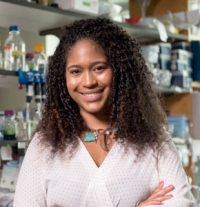44th Annual MLK Celebration Leadership Award Recipient: Tsehai Grell
Tsehai Grell ’G
Chemistry
44th Annual MLK Leadership Award

Expanding the pipeline to graduate school
Outside of the chemistry lab, PhD candidate Tsehai Grell works to make MIT more inclusive for grad students.
Dara Farhadi | MIT News correspondent
August 22, 2017
Tsehai Grell grew up in a small island nation in the Caribbean called the Commonwealth of Dominica. Known as “the nature island,” Dominica features black sand beaches, rolling mountains, tropical green foliage, and a close-knit community.
“I grew up there and I wouldn’t trade it for the world. It’s a warm, friendly culture. You cannot walk into a room without greeting everyone, even if you don’t know them. Even on the street you say hello,” says Grell, a rising sixth year PhD candidate in the Department of Chemistry.
Many people in this supportive environment helped launch Grell on her path to academic success. “It wasn’t just my family; my whole community wanted to see me succeed,” she recalls. “They were equally as proud of me as my parents were, because they had a hand in raising me to become the person that I am today.”
Grell has carried that “it takes a village” philosophy with her to MIT, where in addition to conducting research at the interface of chemistry and biology, she has been active in a number of efforts that encourage underrepresented minorities to pursue graduate studies in STEM fields.
MIT’s enrollment data attests to the importance of these initiatives. For example, as of fall 2016, black and Latino students represented roughly 21 percent of MIT’s undergraduate class but only about 7 percent of the graduate class.
Grell believes the variety of MIT students’ experiences and perspectives is one of the Institute’s greatest qualities. “When you don’t have diversity of thought and experiences, you are missing out on a number of problems and potential solutions, especially in the research lab,” she says.